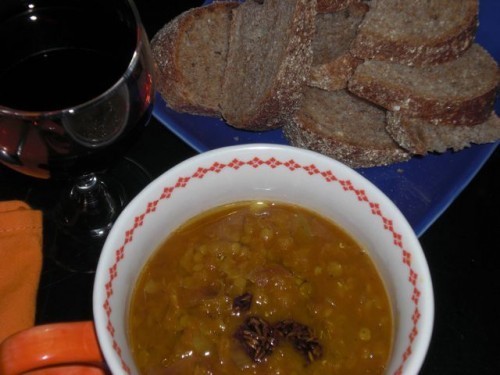Sherrie Flick's Blog, page 4
June 28, 2011
Artists Eat (at my house): James Simon
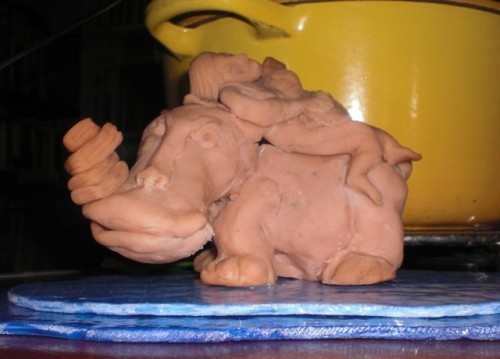
Sculptor James Simon is one of my oldest Pittsburgh friends. Together, we've weathered the storm of finding our way in a new city. We've pulled together many art events (from literary readings to Sunday brunch classical music performances) in his studio space, embracing the idea if we can't find it, let's make it happen. Along the way, for the past 10 years, I've fed him.

Recently, he came over carting a tiny hippo. Usually James creates larger-than-life sculptures—15 foot tall musicians and mosaics and big weiner dogs. But for me he went micro. The little happy hippo, which sat on the table nestled amongst the dishes through dinner, features a stack of books and a woman reclining on its back playing a ukulele. Me, in other words.
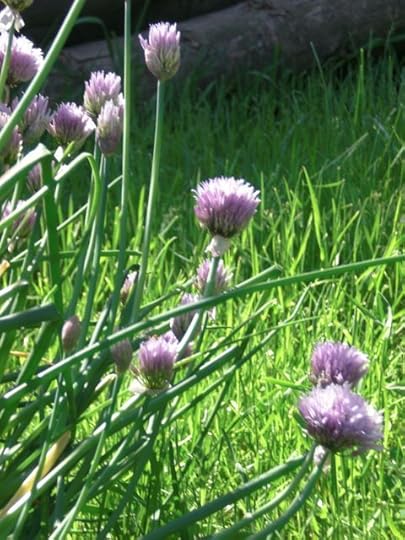
The idea for the evening's dinner was to highlight my garden's fresh herbs. Over the years I've cultivated a whole patch of wonderful plants: oregano, chives, lavender, sage, hyssop, mint, lemon balm, borage, cilantro, marjoram, caraway, savory, thyme, tarragon, and rosemary (in a pot which I lug inside and then back out each year).
The menu included a Lavender and Chive Flower Potato Soup; a fresh garden salad featuring radishes and a multi-herbed vinaigrette; baked onions stuffed with fresh sage, chard, and pine nuts in a bechamel sauce; a plate of roasted beets, smoked trout, feta, fresh thyme, hard-boiled eggs, and cucumbers (prepared by the wonderful Christina Worsing), and a rosemary cake with homemade apple chutney. (I forgot to make lemon balm tea to serve with the cake, which was the plan.)
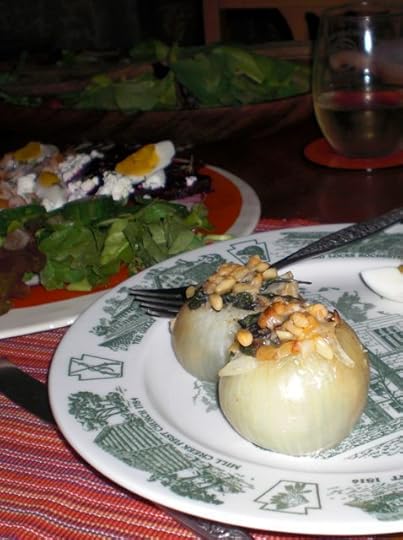
I like that the herbs directed the meal and nudged me out of my cookbook comfort zone. My favorite of the line-up was the Lavender and Chive Flower Potato Soup. I have a hearty patch of chives, and I never know quite what to do with them. This soup is quick and easy and has a wonderfully unique, earthy taste.
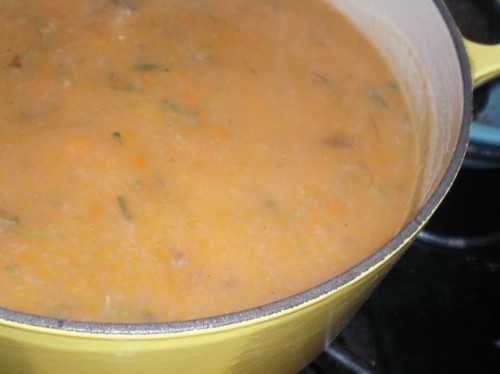
Recipe
Lavender and Chive Flower Potato Soup
(adapted from the recipe posted on My Flower Recipes)
1 lb. potatoes, quartered (peeled or unpeeled)
1 lb. yellow onions (2 large onions), peeled and quartered
½ lb. carrots (5 medium carrots), roughly chopped
1 Tbls. sea salt
6 cups vegetable stock
¼ cup chive flowers, roughly chopped
¼ cup fresh chives, roughly chopped
1 Tbls. fresh lavender flowers
More chive or lavender flowers for garnish
Add the potatoes, onions, and carrots with the salt to the stock. Bring to a boil and then simmer for about 30 minutes. Add the chive flowers, chives, and lavender. Simmer 10 minutes more.
Pulse with an immersion blender (keep it toward the chunky side) or pour the whole soup (in batches, if needed) into a blender or food processor and then return to the pot to warm. Check to see if it needs more salt. Serve warm with crusty bread.

The Chive Flower soup was out of this world earthy and sophisticated—proof again that healthy food can taste great! The oddball but delicious dish of the night was a stuffed onion (because I had never seen a stuffed onion before) with all kinds of tasty stuff inside … Swiss chard, sage, pine nuts … there was a salad with smoked trout which was quite tasty and took me back (in a good way) to my Jewish kid days when my grandma would spend hours preparing some kind of traditional smoked white fish. For dessert there was a rosemary cake with apple chutney topping. Now I'm not a big dessert eater, but this was pretty good. The cake, not too sweet, with the Indian style applesauce combo—a delight to the taste buds. If you ever get invited to a Sherrie Flick dinner you are in for an adventurous treat!
James Simon lives in Pittsburgh, Pennsylvania. He is a professionally-trained lutier and restorationist turned sculptor whose work has been interpreted as a fusion of High Renaissance technology, contemporary art, and primitive form.
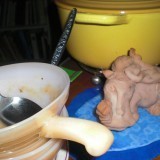
June 22, 2011
Food and Writing and Life and Food: Orange-Lavender Pound Cake
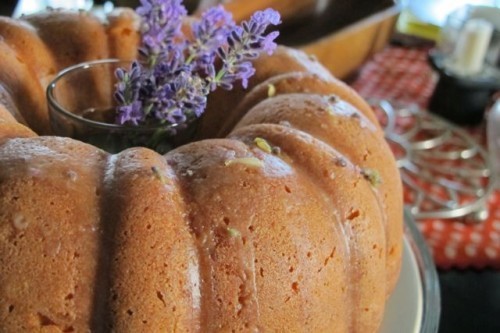 Food
FoodThis blog exists because I published a novel. The novel exists because I worked at a bakery. The bakery, Ceres Bakery in Portsmouth, New Hampshire, served as the start of my food education. The women there taught me most everything I know about baking and cooking and feminism and living a good, fine, adventurous life.
Writing
I met my husband in grad school, where I went to refine my writing, a process that would lead to publishing my novel, eventually. There, in a writing workshop in Lincoln, Nebraska, I invited Rick to my house for dinner. I made green bean and sweet potato turnovers. Fourteen years later, he still talks about them.
 Life
LifeFor our wedding, a baker from Ceres Bakery, the wonderful Cheryl Krisko, made our cake. She also married us—at my parents' farmhouse in rural Pennsylvania. The cake—an orange pound cake with grand marnier glaze and a white chocolate buttercream—was magnificent. Not one crumb was left on the doily as the sun set that day.
Food
The cake itself is regularly made as a bundt cake with an orange glaze at Ceres Bakery, and to complete this blog circle, it has a cameo in chapter 16 of my novel, Reconsidering Happiness. Ceres Bakery—renamed Penhallow Bakery in the book—threads all of the characters together in the nonlinear narrative.
Writing
I didn't go back to Ceres Bakery to research and fictionalize those scenes but instead remembered the details of my own baking and the place and the people—so it's a nostalgic rendering that has struck many, who have purposefully or accidentally ventured into the bakery after reading the book, as accurate.
Food
Last night, for our 14th wedding anniversary I made dinner. Goat cheese tarragon flan with garden greens and a French lentil cucumber fennel salad. I decided to revision the orange pound cake using the freshly blooming lavender in our garden.
Writing
In 2009, when my book came out, the wonderful Clara Silverstein wrote an article about it and Ceres Bakery for the Boston Globe. In the article she included the recipe for the orange pound cake and glaze, which I'll link to here.
Food (Recipe)
What I did was add 1 Tablespoon of whole fresh lavender blossoms to the batter by spreading half of the batter into the pan, sprinkling in a layer of lavender, and then gently spreading the second half over top. I also added a Tablespoon of finely minced fresh lavender blossoms to the glaze.
Life
The subtle lavender mixed wonderfully with both the fresh orange zest in the cake and the juice in the glaze. It made the simple pound cake elegant. We ate it on our deck with a glass of wine. The night sunk in around us and summer sounds crept up from the garden as we toasted to us.
June 14, 2011
Pea Almond Tart: Pea Fest 2011
 Every March, as close to St. Patrick's Day as I can get, I plant the peas in my backyard garden. Some years I scratch away snow and shove the round green peas into the stiff ground, not optimistic about their future. Other years, I'm in a T-shirt and it's a luscious spring day. In Western Pennsylvania, people swear by this planting date.
Every March, as close to St. Patrick's Day as I can get, I plant the peas in my backyard garden. Some years I scratch away snow and shove the round green peas into the stiff ground, not optimistic about their future. Other years, I'm in a T-shirt and it's a luscious spring day. In Western Pennsylvania, people swear by this planting date.
It works. My peas are a glorious early crop that brings so much satisfaction. I tell people I don't even know that I've just harvested my peas and pass out small bags of them to neighbors. 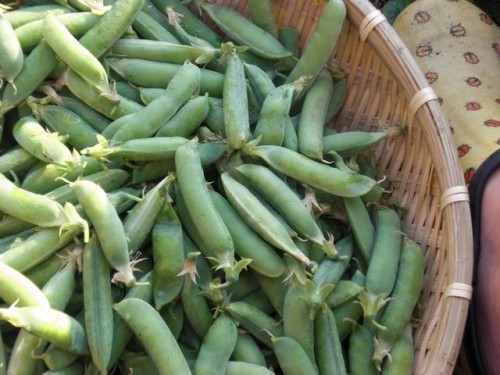
The day of the pea harvest I get together with my friends Leslie and Christina, and we design a meal we call Pea Fest.
This year, along with Christina's brilliant Thai gimlets (kefir leaves, chilis, vodka, lime juice!) and fish cakes, and Leslie's delicious key lime pie with a gingersnap crust, I made a pea almond tart, garlic scape pesto, and a fresh greens and pea salad. That's Leslie in the photo below, embodying the joy that is Pea Fest. 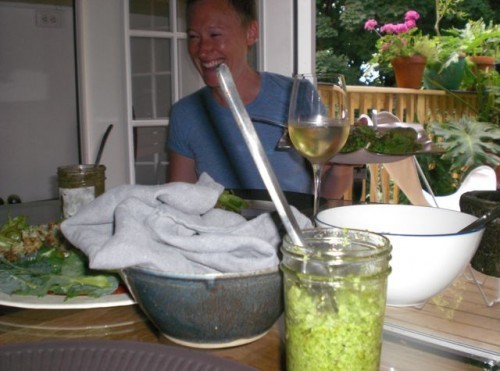
The idea for the pea tart recipe started with a post on Heidi Swanson's wonderful blog 101 Cookbooks. I've fiddled with it a bit, adding almonds instead of pine nuts and sticking with a traditional tart recipe but one made with sucanat to add good texture. 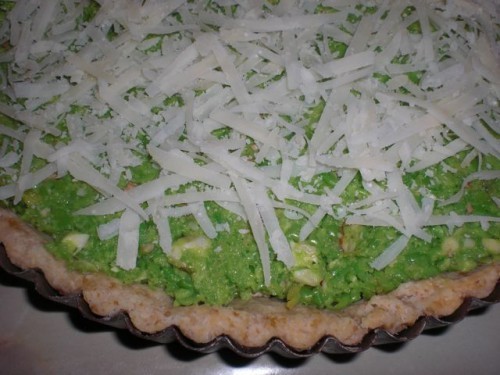
If you see fresh peas at your local market, grab a big bag and a couple of friends and enjoy.
Pea Tart Recipe
Filling
1 lunch sack filled with pea pods, about 4 cups of peas once shelled
Juice of half a lemon
½ c. almonds, chopped
½ c. grated FRESH parmesan
Pinch of cayenne
Zest of one lemon
Salt and pepper to taste
¼ c. of piave cheese, grated, for the tart top
Find a comfortable chair and two bowls. Put on some music you love. Sit down. Shell the peas by zipping them free of their pods. Roll the fresh peas into one bowl; toss the empty pods into the other. Repeat.
Get a big pot of water boiling. Throw in a pinch of salt. Blanch the peas in the water for no more than 20 seconds. The peas will begin to rise to the surface of the water at about this time. Strain them out and directly into the bucket of cold, iced water you have waiting. (This stops them from cooking and retains their glorious green color.) Strain them out of the ice water, set aside.
Put the peas into a food processor and pulse, add the lemon juice, almonds, cayenne, and zest and grind it all into a beautiful green goo. Add salt and pepper to taste.
Crust
1 ¼ c. non-bleached white flour
1 Tbls. sucanat sugar
1/4 tsp. salt
½ c. chilled unsalted butter, cut into chunks
2 Tbls. cold water
Pre-heat oven to 425 degrees.
In a big mixing bowl combine flour, sugar, and salt; rub in the butter by sliding your thumb against your pointer finger until you get a nice pebbly consistency. Add the water. Mix gingerly until incorporated. Make a flat disk of the dough, place it into a 9-inch tart pan and carefully push the dough out toward the fluted edges using your fingertips until it uniformly fills the pan and looks like a tart crust. If the dough sticks to your fingers, plunge your hands into the flour bin to coat them and continue spreading the dough.
Par-bake the crust
Fit a doubled piece of aluminum foil snugly into the formed crust and poke a few holes in it with a fork. Bake the crust for 8 minutes with the foil on, 4 more minutes with the foil removed. (The crust should go from shiny to dry-looking in those final four minutes.) Let the crust cool completely. After about five minutes on a cooling rack, you can put it in the frig to help this process along.
Fill the crust; bake the tart
Bring the oven temp down to 400 degrees
Once the crust is cool, add the pea goo. Fill it to the brim, and spread it smooth with a spatula. Sprinkle it with the grated piave cheese and grind some black pepper on top. You could also add some freshly snipped herbs at this stage as well, although I like to keep it pretty simple to let the peas' taste shine through.
Bake the tart for approximately 20 minutes or until the tart crust is nicely done and the cheese on top is just, just starting to brown. Let cool in the tart pan and then remove. Eat at room temperature or eat warm. Enjoy.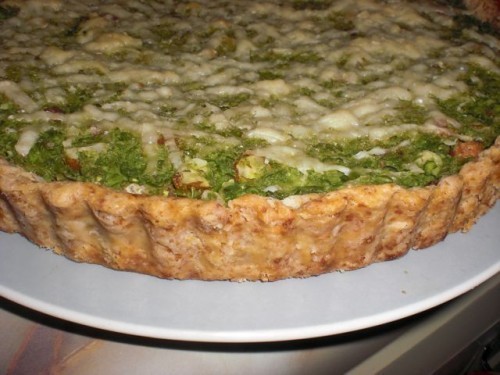
June 7, 2011
Grilled Cheese Improvisation: Kale and (a tiny bit of) Onion
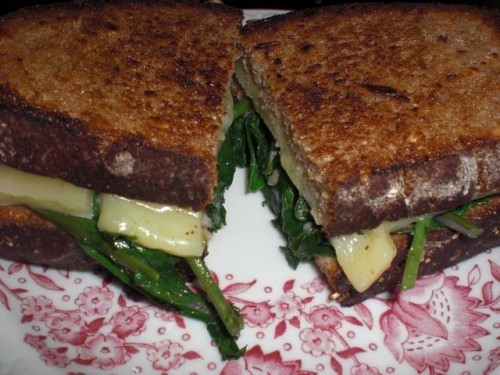 After weeding all morning, I snip three large leaves from the Russian kale plant that has over-wintered in my garden and stumble inside out of the noon heat. The next thing I know I've got the cast-iron pan going on the stove, and after rinsing and de-stemming the kale leaves, I saute them for a couple minutes in a tiny bit of butter, adding salt and pepper, until they turn turn a rich, dense nutrient-laden green.
After weeding all morning, I snip three large leaves from the Russian kale plant that has over-wintered in my garden and stumble inside out of the noon heat. The next thing I know I've got the cast-iron pan going on the stove, and after rinsing and de-stemming the kale leaves, I saute them for a couple minutes in a tiny bit of butter, adding salt and pepper, until they turn turn a rich, dense nutrient-laden green.
I dig the remains of some cheddar and piave cheeses out of the frig and thinly slice them along with a few slivers of yellow onion. After stacking all of this on some hearty sunflower whole-grain bread (cheese, kale, onion) and adding a swish of stone ground mustard, I grill it buttery crispy brown. About 10 minutes from garden to delicious sandwich lunch. Super. Yum.
June 1, 2011
Artists Eat (at my house): Elise Levine and David Smooke
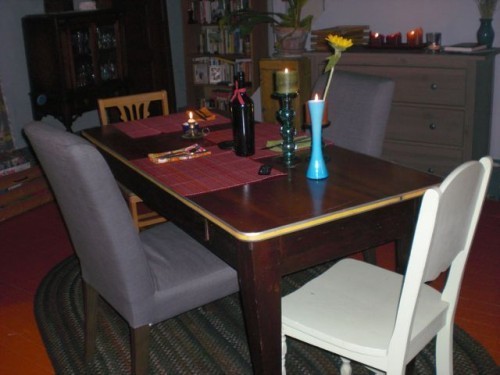
This post is the first installment in a new series: Artists Eat (at my house) where artists come to my house to eat, and then share some of their art, posted here along with a recipe. I think it will be fun and creative and tasty. Or, that's the idea.
E2 and Lemon Tart
E2
We met for dinner at e2 in Highland Park on a rainy spring day. After hugs and kisses and it's been way-too-longs, we tucked ourselves into the comfy table by the big chalk board and ordered 4 omgs! (tiny appetizers that make you say, you guessed it): gongonzola mess, roasted garlic, sauteed onions with caraway seeds, and roasted carrots. Add scrumptious crusty bread, and then more bread. We opened the first bottle of wine. Rick had found a deal on a luscious cabernet. (It's byob at e2.)
We shared 3 entrees. Spicy shrimp risotto with arugula and peas, traditional beans and greens with cannelini beans and super nice broth for more bread, and then the portabello arancini (risotto balls) served with piave cheese and fresh tomato sauce. Three balls, diplomatically divided between four people. E2 is a great place to spend a rainy night. Excellent service, amazing food—laid back, fun, and fresh. Our server had corkscrew in hand as we finished bottle 1 and headed toward 2.
After dinner we led Elise and David to the South Side of Pittsburgh for dessert, where they experienced "the slopes" for the first time. We took Aero (their wonderful, patient, wait-in-the-car-while-we-eat big, fluffy dog) on a walk further up in the hills with a great view of downtown and Oakland, and he seemed pleased with both the sights and the smells. We showed David and Elise our little writing studio perched at the top of our yard, and then we test drove the new dining room (which used to be the living room) with lemon tart and prosecco. Our little yorkie, Blue, performed many tricks and offered up first a stuffed toy and then a tiny tennis ball for fetching. Herbie, the ever-disgruntled cat, did not scratch or hiss at either guest. Success.
Rick and I played and sang "Your Cheatin' Heart" (with me on my new banjolele), and we talked about writing and music and teaching and artist studios–about little houses and little spaces. We had such fun, and then it was time for them to pack up and head to Meadville (where Elise had taught for a year) and then to Baltimore (where they live too far away from us).
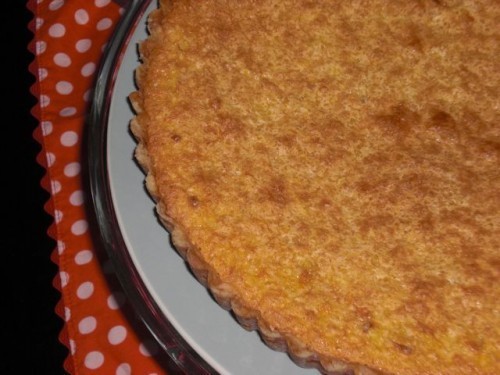
Lemon Tart
I've made this lemon tart ever since I worked at Sally's bakery in San Francisco in the early 90s. There, all of the bakers experimented with recipes and also with ingredients. Although this has no radical Earl Grey tea or applesauce, it remains one of my easy, standby desserts.
I've made this dessert in a cast iron skillet or, more elegantly, in a traditional tart pan. I've made blueberry-ginger sauce for the top and also pretty stenciled designs with powdered sugar. I've used sucanat, regular white sugar, or superfine sugar. All with success—the sucanat gives it a mellower flavor but turns it toward brown instead of a pretty yellow.
I like to make the lemon zest with a zester—using long, skinny strips—instead of grating the lemon into thicker, shorter chunks. The longer zest gives the tart a more elegant appearance but, of course, the taste remains the same either way. It keeps well and some (David) say that it tastes better day 2. On day 3 Rick took the final slice on the Amtrak train to Nebraska and was the envy of all his nearby seatmates.
The Recipe
Crust:
¼ c. powdered sugar
1 c. white flour (My friend Ramona has used brown rice flour with great success)
½ c. cold unsalted butter
Rub, butter into the sugar-flour mix and then sprinkle into a 9-inch tart pan. Press the crust into the pan's grooves and firmly against the bottom. It will be a little crumbly. Don't pay any mind. Form a piece of aluminum foil to snugly fit the bottom, poke a few holes in it with a fork, and then pre-bake the crust at 350 for 20 minutes.
Filling:
3 large eggs
1/4 c. + FRESH lemon juice (about 3 lemons)
1 Tbl. lemon zest (the zest of about 1 lemon)
1/4 c. white flour (See above re: brown rice flour)
1 1/2 c. sugar
3/4 tsp. baking powder
Mix together 3 large eggs, ¼ c.+ lemon juice, 1 Tbl. lemon zest. In a separate bowl mix together 1/4 c. flour, 1 ½ c. sugar (I used superfine for the pic I posted here), and ¾ tsp baking powder.
Whisk the dry ingredients with the wet.
Take the crust out of the oven, remove aluminum foil top, pour lemon goo into crust. PLACE TART PAN ON A COOKIE SHEET BECAUSE THIS TART TENDS TO LEAK A LITTLE WHILE BAKING. Carefully push back into oven. Bake for 25-35 more minutes or until the top is brown and the tart is set (i.e. it doesn't jiggle when nudged). Cool, remove from pan. Display with pride. Eat with friends.

Elise Levine – Fiction Writer
The tart is buttery and zippy, all tension and balance.
Story:
FTW
He might riffle their underwear when they were out, or sit too close to the prettier of them at breakfast the next morning.
One had dark hair, and so did the other. One's breasts were larger, fuller — though not rounder, tenderer. One had better teeth.
Pervert, they were taking turns saying as they had their hike. Across the swale, horses, long-faced, stirred as if listening. Noses up. Twitching, or quivering? Hard to determine given the distance. And those scrappy trees not quite a line that messed with the perspective. And the pickle air — somewhere near, the sea. Correction: sour sea.
So what should they do with the apples with which the offender had burdened them? The owner of the bed and breakfast they were staying at, their suspiciously overly solicitous host — what did he really want? Proffering fruit for the trip, in case they got hungry. In case the wild herd grew less wild, drew near, nibbled out of the womens' hands. That herd — the individual members of which appeared, even at this remove, to be rather large. Nervous. What big hooves each one might have.
Above, there were some clouds. They smudged the far hills. Tainted. Sludged.
The women had traveled far from home to be here.
Slunk. Dodged. Murked — this is how the two women argued in those days. Debated. Decided.
Finally they agreed: bury the fruit. But not deep. Only enough to put the animals off the scent. Not enough to get the hands dirty, the fingernails unclean.
Poor apples. Clearly a sacrifice. The happiest ending would be if they remained apples. Ever wicked, tart.

David Smooke – Composer
Growing up, my favorite dessert was my grandmother's lemon meringue
pie and I've always had a special fondness for lemony desserts and
this one even had a filling that caramelized a bit to create a bit of
a top crust. Although the zest in the tart was exceptional, joining in
with Herbie to watch Bubby explode across the room to fetch one of his
"babies" while being serenaded from the Song-a-Day Ukulele Songbook
with banjolele accompaniment was the true zest of the evening.
Music:
May 25, 2011
One Apple: Happiness, Pancakes
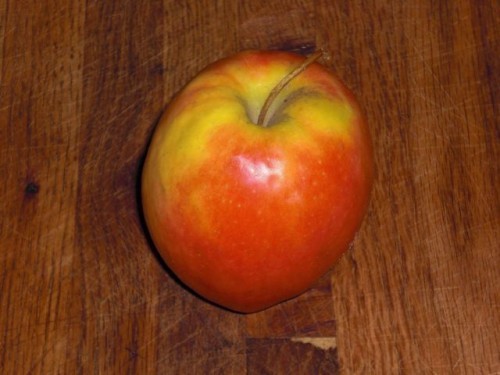 It's amazing how much happiness one apple can bring a household. There had been 6 apples, and in our house, this final piece of fruit would normally sit there until eternity sent it to the compost bin. Not sure why the final apple, the final anything, gets ignored around here. But the Braeburn that tottered in the big bowl we keep on the kitchen counter led me to pancakes.
It's amazing how much happiness one apple can bring a household. There had been 6 apples, and in our house, this final piece of fruit would normally sit there until eternity sent it to the compost bin. Not sure why the final apple, the final anything, gets ignored around here. But the Braeburn that tottered in the big bowl we keep on the kitchen counter led me to pancakes.
Lately, we've been trying to eat everything we purchase to get maximum potential out of our (sometimes expensive) coop shopping, instead of letting good intentions wither in the crisper drawer. And so when I noticed the lone apple, I thought: progress, diced up, into pancakes.
So I invented pancakes—apple walnut wholewheat ginger cardamom pancakes to be exact—on the spot. I pulled up a basic pancake recipe on the internet to get the proportions right, and then had at it, happily puttering in my kitchen in the early morning.
I think they will make you, and whomever you serve them to, happier, too.
Recipe:
Apple Walnut Pancakes
Makes 7 pancakes (at 1/2 c. of batter per cake)
2 eggs
1 3/4 c. milk
juice of half a lemon, squeezed into milk
1 tsp. vanilla
#
1 Tabl. crystallized ginger, chopped
1 c. walnuts, chopped
1 apple, peeled and diced
juice of the other half of the lemon, squeezed over the diced apple
1 tsp lemon zest (optional)
1/4 tsp cardamom
dash nutmeg
handful of oats (optional)
#
1 Tbls. brown sugar
1 1/2 c. wholewheat pastry flour
1/4 c. cornmeal
2 tsp. baking powder
1/2 tsp. baking soda
1/4 tsp. salt
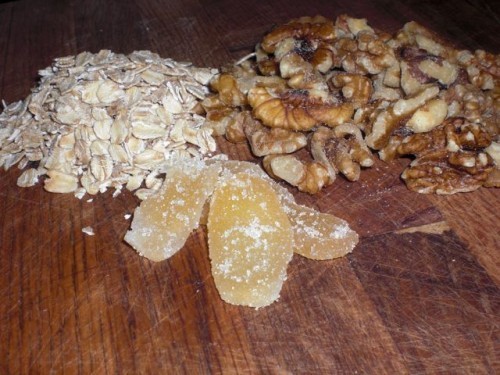 To begin: squeeze one half of the lemon into the milk. This is how you, yes you, can create your own buttermilk. No need to go out and buy a carton that ends up half-full rotting in the fridge. Let it sit for a minute, watch for some mild curdling action. Add the eggs and vanilla. Whisk.
To begin: squeeze one half of the lemon into the milk. This is how you, yes you, can create your own buttermilk. No need to go out and buy a carton that ends up half-full rotting in the fridge. Let it sit for a minute, watch for some mild curdling action. Add the eggs and vanilla. Whisk.
Combine the apple, ginger, walnuts, oats, cardamom, and nutmeg in a small bowl. Lean your nose in and smell. Mmmm.
Mix together the brown sugar, flour, cornmeal, baking powder, baking soda, salt.
Add the eggy-milk mixture to the flour mixture, stir to get things going and then add in the apple mixture and combine until everything is wet and uniform and luscious. Try not to overmix.
Heat a pan at medium to med-high heat, add a little dollop of butter if you'd like (I didn't), measure out a cup of batter and pour it into the HOT pan. There will be bubbles at the top of the batter circle facing you. Watch them pop. It's entertaining. When they've calmed down, check the bottom of the cake, if it's brown, flip it. Set aside on a plate. Repeat until the batter is gone.
Stack onto plates, pour maple syrup over the top, and have a wonderful day.*
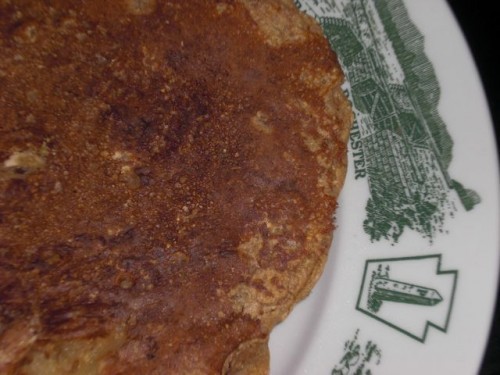 *(Rumor has it if you don't finish all the cooked cakes they are good cold the next day–as a quick breakfast snack.)
*(Rumor has it if you don't finish all the cooked cakes they are good cold the next day–as a quick breakfast snack.)
May 22, 2011
Food Improvisation: Grilled Cheese with Radish
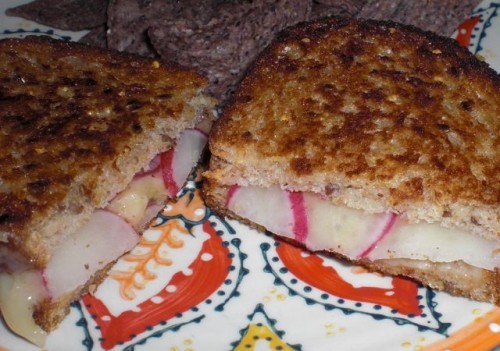 On Friday, I pulled the first radish from the garden. This beautiful little veggie inspired an improvisational grilled cheese sandwich. Garden to lunch in less than 10 minutes. Multi-grain bread with Minerva's extra-sharp cheese, and then thinly sliced radish tucked within. The crunch. A revelation.
On Friday, I pulled the first radish from the garden. This beautiful little veggie inspired an improvisational grilled cheese sandwich. Garden to lunch in less than 10 minutes. Multi-grain bread with Minerva's extra-sharp cheese, and then thinly sliced radish tucked within. The crunch. A revelation.
May 18, 2011
A Friendly Frittata Sandwich
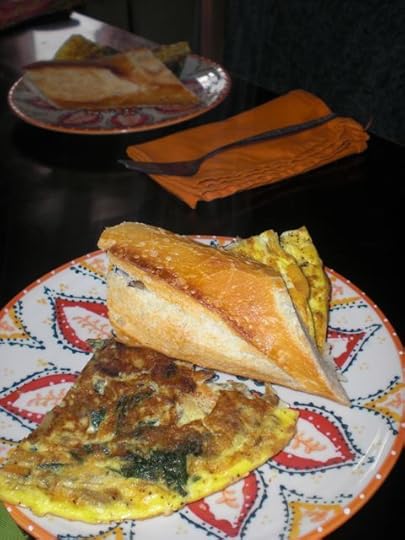 Omelets. When I talk about omelets, I call them "nice." I ask my husband, "Would you like a nice omelet for lunch?" Or, "Why don't we have a nice omelet with that leftover curry?" I'm not sure what led to my friendly assumption about this food, but it holds up. A good omelet is so good–and easy to make. It's the same with frittatas. They're friendly. I especially like using them to finish up produce too small for anything else. One carrot left in the fridge? No problem. The answer, last Saturday, was a carrot-spinach-garlic-onion frittata.
Omelets. When I talk about omelets, I call them "nice." I ask my husband, "Would you like a nice omelet for lunch?" Or, "Why don't we have a nice omelet with that leftover curry?" I'm not sure what led to my friendly assumption about this food, but it holds up. A good omelet is so good–and easy to make. It's the same with frittatas. They're friendly. I especially like using them to finish up produce too small for anything else. One carrot left in the fridge? No problem. The answer, last Saturday, was a carrot-spinach-garlic-onion frittata.
But last Saturday was not your typical eggy day, because we also had a La Gourmandine baguette in the house, freshly purchased (still warm!) that morning. La Gourmandine is a wonderful French bakery in the Lawrenceville neighborhood of Pittsburgh, which serves traditional French baked goods. They have perfect baguettes. Excellent. Sexy. We bought one and most of it made it inside our front door. I had a revelation: friendly frittata sandwiches. The combination of the baguette (chewy on the inside, crisp on the outside) merged with the egg-carrot-garlic-onion-spinach to create a crazy-good breakfast-lunch.
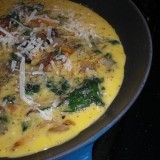
Recipe:
1 Tbls olive oil
1 garlic clove, chopped
1/2 c. of onion, chopped
1 small (beautiful, organic) carrot – slivered into matchsticks
1 c. of spinach (washed and deveined) ripped into pieces
3 eggs, whisked
Dash of milk
¼ c. Parmesan cheese, grated
Salt, pepper
Baguette, cut into 5-inch pieces
Grainy mustard
Heat a frying pan over medium-high heat—then add the oil, then onion, plus the garlic. Sauté until the onion is translucent and smelling fine.
Add the carrot, sauté for a minute or two, then follow with the spinach and a pinch of thyme, salt, pepper. Once the spinach has wilted, nudge the pan's contents onto a separate plate on standby. Crack 3 eggs; add a dash of milk and whisk. I like to get it frothy and light before pouring it into a hot frying pan (either where you've just sautéed the veggies, or a separate pan with a dash of butter). Let the eggs bubble a second in the pan, then scatter the veggies over the egg puddle, along with the parmesan cheese.
Let the egg disk cook until the bottom side browns and the whole structure is firm enough to flip with grace to the other side. Finish off the frittata, making sure it's browned goldenly and firm on both sides, and slide it onto a cutting board, cutting it into four colorful egg wedges.
In the meantime cut the (beautiful) baguette into 5-inch chunks, split in the center with a light smear of dark, grainy mustard. Fold an egg-wedge in half and place it inside the baguette. Egg sandwich bonus. Eat.
May 13, 2011
A Real Blog Post, About Oatmeal
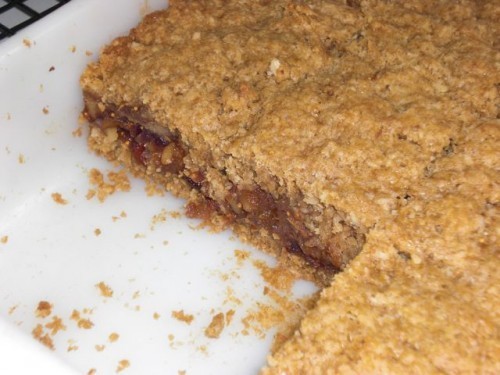 I am an oatmeal-focused person. I eat it daily and make it from scratch in a pan with milk and oats and then all kinds of tasty things thrown in, depending on my mood: walnuts, bananas, dried cherries, crystallized ginger, nutmeg, cinnamon, maple syrup. Last summer, I started making granola at the start of each week and that was easier–just add milk and banana–the tasty stuff already lurked inside.
I am an oatmeal-focused person. I eat it daily and make it from scratch in a pan with milk and oats and then all kinds of tasty things thrown in, depending on my mood: walnuts, bananas, dried cherries, crystallized ginger, nutmeg, cinnamon, maple syrup. Last summer, I started making granola at the start of each week and that was easier–just add milk and banana–the tasty stuff already lurked inside.
Recently, I gave a reading at the amazing Antiquarian Bookstore in Brownville, Nebraska (an eclectic, tiny town nestled into the Missouri Valley) as part of the Wine, Writers & Song Festival. There are several excellent bookstores in Brownville (as well as a tavern (turned healthfood store) that was once frequented by Jesse James), and I purchased a used copy of The Essential Best Foods Cookbook by Dana Jacobi, at the wonderful A Novel Idea: Chapter Two, right on Main Street. As I flipped through the pages I hit upon Spiced Fig Bars on p. 279. Oatmeal spiced fig bars. Oatmeal. In a bar.
Once I got home, I made them, and they are fantastic. I think I'll stick with my weekly granola routine (quickest, easiest), but these little guys will definitely cycle in every so often as a tasty, nutritious choice. Something to take on my next road trip.
Recipe that I've fiddled with a bit:
Ingredients:
1 c. fresh orange juice (about 3 oranges squeezed)
1. c. chopped fresh figs (or dried Turkish)
1/4 c. chopped, pitted dates
1/4 c. cranberries
1/2 c. toasted walnuts
1/2 tsp. cinnamon
1/8 tsp. cloves
1/8 tsp. ground mace
1 1/2 c. organic oats
1 c. whole wheat pastry flour
1/2 c. packed brown sugar
1/4 tsp salt
1/3 c. COLD unsalted butter cut into pieces
1 large egg white
In a medium saucepan bring the orange juice, figs, dates, and cranberries to a boil, then simmer until the orange juice is soaked up. Remove from heat, add the walnuts and the spices, stir, set aside to cool.
Pulse the oats, flour, sugar, and salt in a food processor until the mixture has texture. Add the butter and pulse until you achieve a hint of cornmeal. Add the egg white and pulse until you achieve a kind of clumped, cookie dough appearance.
Press half the oat mixture into an 8 x 8 (buttered!) pan. Spread the gooey figgy filling over the bottom crust. Carefully and with great confidence, sprinkle and spread the second half of the oat mixture on top–making sure to seal up the edges.
Bake for 25+ minutes at 350, until the edges are browning and the top is firm and finished glistening. Cool. Cut them up and eat them. Think: oatmeal.
May 8, 2011
Sherrie Flick's Blog
- Sherrie Flick's profile
- 38 followers


